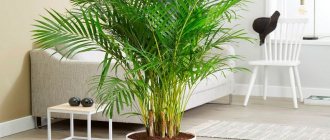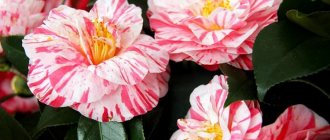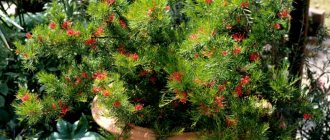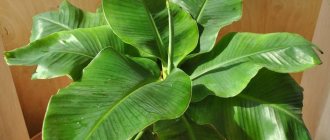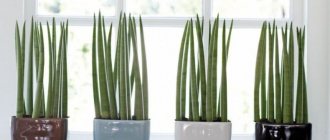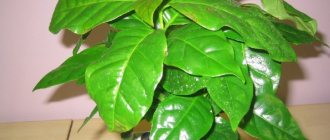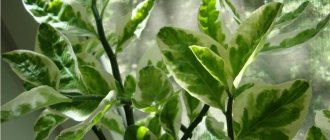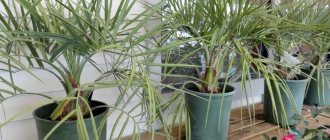Botanical description
Chrysalidocarpus is considered a member of the Palm family, a subfamily of Arecaceae, which has 20 species. The multi-stemmed palm came to us from Madagascar and the Comoros Islands. Locals call the plant the butterfly palm because of the unusual appearance of the leaves, reminiscent of a feathery fan.
In nature, the evergreen plant reaches a height of 7 to 15 meters. In Russia, in protected areas under the roof - from 2 to 5 meters.
Dangerous! The seeds in the fruits are toxic and, if ingested, destroy the mucous membrane.
The palm tree has an amazing feature: it is capable of extracting moisture not only from the soil, but also from the air , but in a dry room it is capable of releasing moisture. One species is cultivated at home - yellowish chrysalidocarpus. Under favorable conditions it grows up to 1.5 -2.0 meters in height. Over the course of a year it adds only 30 cm, but grows in width due to the formation of side shoots.
The originality of the palm lies in the absence of a pronounced trunk. Several herbaceous shoots, similar to reed stems, grow from the ground at the same time.
It blooms under natural conditions in May-June, after which yellow fruits with a hint of gold are formed from self-pollinating buds. It begins to bear fruit 2-3 years after planting.
Relatives of the single-stemmed Chrysalidocarpus are known.
Diseases and pests
Chrysalidocarpus is susceptible to spider mite . The appearance of cobwebs on the leaves is the cause of dry air. Spray the palm tree more often, treat it with an insecticide, and collect visible cobwebs with a cotton swab.
Leaves are drying
Drying leaves, tips, leaf edges are the most common palm problems. The most common problem is lack of humidity.
Spray it more often, move it away from the battery, and place a container of water next to it.
If the problem persists, then it is worth reconsidering the feeding.
Dying and browning of leaf tips may be a signal of excess fluoride, superphosphate, or excess feeding.
If it turns yellow
The appearance of yellow (brown) clearly defined spots on a leaf in summer is a signal that the plant has received sunburn. Move chrysalidocarpus from direct sun to partial shade.
The second sign of excess lighting is the curling of the sheet and the appearance of straw spots on it.
Our experts have prepared a series of materials about other varieties of palm trees. About the secrets of successful cultivation of Dracaena, Date, coconut, rattan, Hamedorea, Gomuti, Rapis, Liviston and Pandanus (screw palm). From them you will learn about the features of growing this plant at home.
What is the difference between Chrysalidocarpus and Hamedorea?
Palm trees are mainly distinguished by their appearance. Chrysalidocarpus grows in two forms - as a bush and a single-stemmed palm. The smooth stems are covered with fluff and there is swelling in the places where the rings are located. Lateral shoots may arise from the shoots, forming a group. The ends of the leaf blades are pinnate, dissected at the ends. The color of the leaves is bright green interspersed with small black dots.
Hamedorea has a much larger number of leaf lobes, which droop downward at the ends. The leaf blades are darker and more saturated in color than those of chrysalidocarpus.
The main difference is noticeable during flowering. Hamedorea inflorescences have the appearance of a loose panicle, while areca has yellow inflorescences that are more dense with a frequent arrangement of flowers. The height of Hamedorea is limited to one meter, Chrysalidocarpus - twice as high.
Yellowish
Chrysalidocarpus yellowish is most often grown as a houseplant in a pot and grows in bush form. Synonym for the generic character dipsis. This species is threatened with extinction in nature, therefore, in the Red List of Endangered Plants, the variety is assigned NT status due to the reduction in the number of the crop.
The plant has special care requirements. Prefers to grow in slightly acidic soil with a pH of 0.0-6.0, does not like moisture retention when watering, but develops well with regular spraying.
You can see what the Chrysalidocarpus Yellowish variety looks like in the photo below:
Chrysalidocarpus Yellowish
Popular varieties and types
Chrysalidocarpus lutescens
This type of palm tree got its name from its yellow-orange stems, densely branching at the base. Leaves of almost the same shade, the so-called fronds, can reach almost a meter in width and up to 2 m in length. The furrowed elongated petioles have a scaly dark cover that disappears with the age of the plant.
Madagascar
The peculiarity of the Chrysalidocarpus Madagascar palm tree is the presence of a strong, smooth trunk on which rings with a diameter of 20-25 cm are visible. Cirrus leaves with a characteristic smooth surface usually grow in bunches. The length of the leaf blade is slightly less than half a meter and usually its size is 40-45 cm, which cannot be said about the width, which is small - 1.5-2 cm.
The photo below shows Chrysalidocarpus Madagascar:
Chrysalidocarpus Madagascar
Main types
Chrysalidocarpus lutescens
This plant is a bushy plant and is quite branched at the base and has rooting side stems. The petioles of the leaves and young trunks are light yellow with small dark black dots. Their surface is relatively smooth. The arcuate leaves can reach 200 centimeters in length, and their width is 80–90 centimeters. Each leaf consists of 40–60 pairs of non-dragging, fairly strong leaflets, reaching 15 millimeters in width. The grooved petiole can reach a length of 50–60 centimeters. It is colored yellow and on its surface there is a layer of blackish small scales. The axillary inflorescence is highly branched. This dioecious palm prefers to grow in a warm room.
Lutescens
The Lutescens palm lacks a central trunk. The stems of the plant develop powerfully and grow closely adjacent to the trunk. The gracefully curved leaves have a feathery shape with a characteristic yellowish tint. It blooms in late spring - early summer with yellow flowers united in dense branched inflorescences. The fruits formed after flowering have the same yellow color.
In the photo below is the variety Chrysalidocarpus Lutescens:
Chrysalidocarpus Lutescens
Care
Since the palm tree is considered a tropical plant, the scorching sun is not harmful to it. But young plants at high temperatures may suffer from excess sunlight.
Lighting
The plant is tolerant of partial shade and bright indirect sunlight, but excessive shading should be avoided. Direct sunlight can damage young chrysalidocarpus seedlings, causing the leaves to begin to turn yellow and curl. Without protection, the palm tree sheds its leaves and dies when it is exposed to the sun at its hottest from 11:00 to 16:00. At this time, it is better to shade the palm tree if it is not possible to move it to another place.
After chrysalidocarpus reaches the age of 6 years, there is no need to be afraid of the sun. The plant will be well lit when placed on south and southeast windows. From July to August, shading windows with tulle or paper saves you from the midday heat.
Expert opinion
Victoria Goncharova
Specialized education: landscape designer, agronomist, gardener. Experience in caring for potted fresh flowers/plants at a professional level!
Do not forget! To prevent it from being dense on one side and empty on the other, rotate the chrysalidocarpus 2 times a month around its axis by 180 degrees.
Temperature
Chrysalidocarpus transplantation
transplantation . Therefore, this procedure is carried out only when the roots of the plant no longer fit into the old pot.
Adult plants are replanted once every 3 years. The rest of the time it is enough to replace the top layer of soil.
Young plants are replanted every year in the spring. The pot must have a drainage layer. The larger the pot and the more mature the plant, the thicker the drainage layer should be.
feeding in spring and summer. To do this, just take a standard complex fertilizer intended for palm trees and dilute it 10 times. Nothing more is required.
Recommended by topic
Basella Hamedorea Crocuses Temperature changes are not a problem for palm trees after 10 years of life.
They can withstand short-term temperature drops to +13°C-16°C; the palm tree cannot tolerate temperatures below 14°C. For young chrysalidocarpus in the summer season, the favorable temperature is 22°C-25°C. In winter – within the range from 18°C to 23°C, but not less than 16°C. Ventilation of the room where the palm tree grows becomes a prerequisite in the summer. It is necessary to avoid drafts, since cold air harms the leaves, which begin to wither due to the disappearance of the protective layer from the leaves and loss of moisture, and may fall off. Free air circulation must also be ensured in winter. If the palm tree is small in size, you can take it out of the room while airing. It is important to protect chrysalidocarpus during transportation from the store by creating a draft barrier with packaging material.
Humidity and watering
Moist air is vital for palm trees. It is ideal for the plant when there is a humidifier in the room, especially when the heating system is turned on in winter. You can get out of this situation on a budget by placing the chrysalidocarpus on a tray with damp gravel or placing a container of water nearby.
You can practice regularly wiping palm leaves with a wet sponge dipped in settled water at room temperature. Removing dust allows the plant to breathe better and absorb more oxygen from the air.
In winter it sprays the palm tree once a week, in the summer season - 2-3 times. The plant gratefully responds by growing green mass to bathing in the shower. First you need to cover the soil in the pot with plastic wrap. This procedure is carried out once every 2 weeks.
Chrysalidocarpus is most thirsty in the summer, especially if the sun shines on the plant. Water the palm tree as the top layer of soil dries to a depth of 2-3 cm. It is important to prevent the root system from drying out. The water must be settled. Soften the water with several crystals of citric acid.
Palm trees develop well when watered:
Thaloy
Rain
The plant should not be allowed to overwater, as this stops the development of the root system, it begins to suffocate and rot. The regularity of watering in summer is 2-3 times a week; in winter, watering is reduced to once a week. In winter you need to focus on the condition of the palm tree; here it is better to act according to the principle - it is better to under-water than over-water.
Top dressing
Palm trees are fertilized from April to August. This is the key to success in growing a beautiful plant. In spring and summer, the frequency of fertilizing is 2 times a month. For feeding, it is better to use a complex fertilizer for decorative deciduous plants or a special fertilizer for palm trees.
During the growing season, foliar feeding is practiced by spraying the leaves with a weak solution of fertilizers.
Nutrient deficiency is determined by the appearance of chrysalidocarpus:
The light green color of the leaves indicates a lack of nitrogen and stunted growth.
Magnesium - the appearance of a light yellow stripe along the edge of the leaf
Potassium - in orange islands on the leaves
Zinc – along small necrotic brown spots
Unexpressed chlorosis manifests itself from a lack of magnesium. These points must be taken into account when selecting fertilizers, and focus on complex species that contain all the microelements necessary for the successful development of the plant.
Transfer
Chrysalidocarpus has an extremely negative attitude towards transplantation. Transshipment with subsequent filling of soil is used. The palm tree is replanted only when there is a possibility that the pot will rupture due to roots coming out. Young palm trees need to be replanted every year, adult plants - once every 3 years.
It is optimal to transplant in April with the obligatory preservation of the earthen coma.
Some of the roots that have become tangled and turned into a felt layer are cut off. Transfer the palm tree to a new pot in such a way as not to deepen the palm tree trunk. It should coincide with the ground level before replanting. When chrysalidocarpus is grown in a tub and the palm tree has reached an impressive size, the top part of the soil is removed and replaced with new one. It is unacceptable to transplant a small chrysalidocarpus into a large pot, since the plant is not able to absorb all the water when watering and will die due to rotting of the roots.
Priming
Signs of good soil for chrysalidocarpus lie in the ability not to retain water when watering. When water is retained through the drainage hole for more than a minute, this indicates that the soil is heavy and needs to be drained.
For drainage use:
Pebbles
Large perlite
Peat
Coarse sand or 2 cm pieces of wood chips
If the substrate contains clay soil or fine sand, these elements reduce soil drainage.
You can buy ready-made soil specifically for growing palm trees in a store or prepare it yourself:
2 parts leaf humus
2 parts perlite
1 part turf land
You can use a different composition - take in equal parts:
Pumice
pine bark
Charcoal or perlite
Dolomite crushed stone or pebbles
Then add to this composition:
Two parts of peat
1/10 part bone meal
The ideal soil for palm trees is acidic or neutral acidic, with a pH value of 6-7.5.
Possible problems arising during cultivation
When growing areca chrysalidocarpus palm, you can encounter a number of problems that will not only negatively affect the appearance of the plant, but can even lead to its death. A palm tree can be affected by a variety of diseases and pests that do not mind profiting from the nutritious juice of its leaves.
Leaves dry on a palm tree
Most often, chrysalidocarpus leaves or their tips dry out due to improper care or improper maintenance conditions. The palm tree often suffers due to dry air and lack or excess of moisture.
In order for chrysalidocarpus to be in excellent health, sudden temperature changes should not be allowed. Otherwise, its leaves will darken and dry out.
Dried leaves
In winter, the palm tree does not need to be placed near the heater. It dries the air too much and causes great harm to the leaves, which lose their decorative properties. If the house is small and there is no way to avoid placing these flowers near the heater, then you must place a bucket of water next to them.
Pests and diseases
Most often, Chrysalidocarpus dipsis is attacked by:
- Mealybug. You can easily guess about the appearance of this pest, since the palm tree seems to become sprinkled with pieces of cotton wool, and its leaves turn yellow and wither. This parasite appears in conditions of very high humidity and temperature. To get rid of spider mites, you should moisten cotton wool with alcohol and eliminate the pests, and the plant itself should be sprayed with insecticides.
- Spider mite. With its appearance, the palm tree becomes covered with cobwebs, and yellow specks first appear on the leaves, and then they dry out completely. Dry air is a favorable condition for this parasite. To avoid the appearance of the pest, it is necessary to maintain high air humidity and treat chrysalidocarpus with acaricides.
If you thoroughly study the topic of chrysalidocarpus care at home and conscientiously follow all the recommendations, you can avoid many problems. Palm trees will definitely delight the eye with their luxurious leaves, regardless of the time of year.
Reproduction
Attention! Chrysalidocarpus does not propagate by cuttings.
Flower growers propagate palm trees by seeds or suckers formed from the lower buds. The best period for breeding is late spring–early summer.
Seeds
With the seed method of propagating chrysalidocarpus sprouts, you have to wait several months. Great disappointment awaits gardeners who purchase seeds from unverified sources on the Internet, which after a long waiting period do not germinate at all.
The whole process takes place in several stages:
The seeds are soaked for 2-3 hours in warm water with the addition of a few crystals of potassium permanganate so that the color of the liquid is slightly pink.- A wide plastic container is filled 2/3 with peat and seeds are planted in it, deepening it by 2 cm.
- They create a greenhouse effect for seed germination by covering it with glass or transparent plastic film.
- Install in a well-lit place and maintain the temperature at least +23°C.
- Do not allow the soil to dry out, regularly water and ventilate the improvised greenhouse for one to two hours.
- As soon as all the seeds germinate and sprouts appear, a separate container is prepared for each of them, filled with soil and the seedlings are transplanted.
Offspring
It will take just a few weeks for the root shoots to take root. Therefore, this method of reproduction is considered faster and more effective:
Young shoots of chrysalidocarpus are separated from the mother bush with garden shears or a clerical blade.
The shoots are placed in water for several days, to which the growth stimulator Kornevin, KorneStim or Root Super is added.
Next, the offspring are planted in small pots filled with substrate and placed in a dark place.
After the shoots have started to grow, the pots are moved to the windowsill, avoiding direct sunlight.
Helminthosporiosis
Helminthosporiasis refers to a fungal infection. Signs of a diseased plant are the appearance of small reddish spots in the shape of an oval. At the initial stage, the disease develops on the rim of the leaf, gradually covering the entire surface. The reason lies in waterlogging of the soil and spraying of chrysalidocarpus. Therefore, watering and spraying are temporarily excluded. If the problem does not go away, treat chrysalidocarpus with fungicides.
Important! When using chemicals, test the drug on a small area of the leaf to prevent the death of the palm tree.
Signs and superstitions about chrysalidocarpus
Chrysalidocarpus areca care at home photo
Sometimes people wonder: can a chrysalidocarpus palm be kept at home? Based on research conducted by scientists, chrysalidocarpus yellowish, along with aloe vera and chlorophytum, is able to cleanse the air of harmful substances, including formaldehyde and even heavy metals. Increases air humidity, enriches the air with ozone and oxygen.
For those who are interested in Feng Shui, the butterfly palm will maintain a favorable environment in the home. It is dual, so it can give positive energy and take away negative energy, especially from sharp corners.
This beauty can develop a natural bush feel even in the smallest of spaces. And in general, it’s a pleasure to look after her, because the green color has a positive effect on the psyche and calms her down.
It is important: you should be careful when handling the fruits and seeds of this beauty. They are poisonous! Under no circumstances should they be used for food or self-medicate. Can cause significant harm to the body!
Chervetsy
If you notice that the chrysalidocarpus has slowed down, the leaves have shriveled and began to fall off - check, it’s likely that a mealybug has settled, which lives not only on leaf blades and stems, but also in the soil, affecting the roots. The pest is popularly called a hairy louse, since the nests of the pest are similar to lumps of white cotton wool.
In the initial stage, they try to clean the chrysalidocarpus with a brush or cotton swab dipped in a soap or alcohol solution. But it’s better not to wait for the scale of the scale insect to spread, since traditional methods rarely work in this case. Getting rid of scale insects is difficult even when using chemicals.
The mechanical cleaning method is used in conjunction with the chemical one. It is more effective to treat chrysalidocarpus once a week with Aktara, Calypso, Condifor, Mospilan, etc. Proceed strictly according to the instructions, without trying to reduce the dosage, as it will not be possible to achieve a therapeutic effect. If the dosage is exceeded, chrysalidocarpus leaves burn.
What problems might there be and how to solve them
Chrysalidocarpus is an evergreen plant with bright green, dense foliage. With improper care, some signs may appear that can be easily eliminated.
Leaves are drying
If the leaves take on a withered appearance, and over time the ends become dry and brown, the microclimate is too dry . This drawback can be eliminated by regularly ventilating the room, avoiding drafts for chrysalidocarpus. Increase air humidification.
Overflow
With sufficient moisture in the soil, the palm tree has the appearance of erect trunks that are kept crowded together. When the soil gets too dry, the bush falls apart. If the bush looks crowded, but at the same time lethargic, this is a sign of overwatering. Brown spots also appear on the foliage. To quickly drain the soil, loosen it and pierce it with a thin stick along the edges of the flowerpot in several places for ventilation. Make additional drainage holes, place folded paper napkins on the top layer of soil and under the flowerpot, regularly replacing them with dry ones.
If several days have passed and the situation has not changed, then take the plant out of the pot. Carefully wash the soil and inspect the roots. Watery areas are removed and the cuts are treated with fungicides. Planted in new soil. To prevent root rot and fungal diseases, distribute 1 tablet of Glyocladin and Alirin .
When watering for the first time, lightly moisten the soil. After drying, set the watering regime once a week.
Pests
Healthy chrysalidocarpus has smooth, uniformly green leaves. White spots indicate the presence of pests, which can often settle on it. The most common:
- Mealybug.
- Spider mite.
If the palm tree turns yellow and a white coating is found in the axils, and a sticky liquid appears on the inside of the leaf, then these are signs of mealybug . It feeds on plant juices, slowing growth and development. In the waste of its vital activity, a sooty fungus develops, affecting the root system and above-ground parts. It spreads very quickly to neighboring plants.
If white spots appear on the leaves, they curl and dry out - the cause is spider mites . It can be detected on the reverse side of the leaf by the presence of a thin transparent web. In addition to feeding on plant sap, it is also a carrier of gray rot. The plant is sprayed only with acaricides - insecticides do not work in the fight against mites. He quickly adapts to the drug.
Before using protective agents, plants are treated with laundry or green soap, thoroughly wiping the leaves on both sides, axils and trunks. Leave for 15 minutes and then rinse with water.
| Pests | Active drug | Dosage of the drug and water | Mode of application |
| Mealybug | Aktara Aktellik | 1 g per 1 l 1 amp. for 200 ml | Spray plants and soil. Repeat the course after 2 weeks, changing the drug. |
| Spider mite | Kleschevit Fitoverm Fufanon-Nova | 2 ml per 1 l 1 amp. for 1 l 1 ml per 1 l | Spray plants and soil. Repeat the course after 2 weeks, changing the drug. |
Advice: do not take indoor plants outside, where pests can easily settle on them.
Spider mite
The cause of spider mite damage to chrysalidocarpus is dry air. When a silvery-white web begins to entangle the leaves, there is no doubt that a colony of mites has begun to actively reproduce, and comfortable conditions have been created for it to reproduce. What cannot be said about chrysalidocarpus.
At the initial stage, the conditions of detention and care are changed.
Provide the palm tree with a constant flow of fresh air and give it a warm shower 2 times a week, thereby reducing the parasite population. The acaricidal preparations Apollo and Flumite are also used; at the initial stage, the insecticides Fitoverm or Actellik have a good effect. Attention! It is impossible, in an attempt to kill spider mites, to cover the chrysalidocarpus with a film cap after treatment with drugs. This kills the ticks, but also the palm tree, which may die.
The tips of the leaves are brown
When the tips of the leaves turn brown, this indicates dry air in the room, especially in winter when the heating is turned on.
Increasing the number of sprays will not solve the problem. Additionally, the surface of the soil is covered with damp moss, and a pot with chrysalidocarpus is placed on a tray with a layer of wet expanded clay sand. Containers of water are placed next to the palm tree.
Store-bought humidifiers that stick into the soil and fill with water have been proven effective. You also need to protect the palm tree from direct sunlight.
Brownish spots on the foliage
As soon as the room temperature drops below the optimal temperature of +16°C and reaches 0°C, brown spots appear on the leaves of the chrysalidocarpus. Obviously, as soon as the temperature is increased, the situation improves. Drafts have a similar effect on the leaves, therefore, this must be taken into account when ventilating the room, moving the pot to a protected place.
There are times when chrysalidocarpus leaves begin to darken, this is a response to abundant watering, which needs to be reduced. Sometimes the care rules are not violated, but the leaves still darken. This happens because the sheet plates are often touched with hands, and not always with clean hands. Take this nuance into account when growing chrysalidocarpus.
Why do leaves dry and what to do?
This can happen due to poor quality water when chrysalidocarpus is watered with hard tap water. The problem can be quickly corrected by allowing the water to settle for 24 hours, or by watering with melt or rain water.
The yellowish-brown color of the leaves indicates waterlogging of the substrate. The roots may smell rotten. A similar picture is observed when there is a lack of moisture, when the earthen ball dries out. Watering should be normalized.
Watering the plant
Chrysalidocarpus should be watered regularly. The plant is quite capricious in this regard. Regular tap water is not suitable for watering palm trees. You should use filtered or bottled water.
If such water is not available, then ordinary running water should be left for several days.
This should be done because chrysalidocarpus is very sensitive to chlorine and other impurities. The plant is also very sensitive to water hardness.
The palm tree should be watered only when the top layer of soil in the pot has dried out a little. You should leave it in this state for a couple of days and then water it generously.
In the autumn and winter, watering should not be done so abundantly so that root rot does not eventually develop.
to limit yourself to spraying the plant twice a day with a spray bottle in winter
If the watering is abundant and there is water in the pan, it should be removed to prevent rotting of the roots. You should also ensure that water does not get on the main stems. Lack of moisture is also an extreme.
If the soil dries out , then the leaves of the chrysalidocarpus will begin to die over time, and it will be almost impossible to save the plant.

